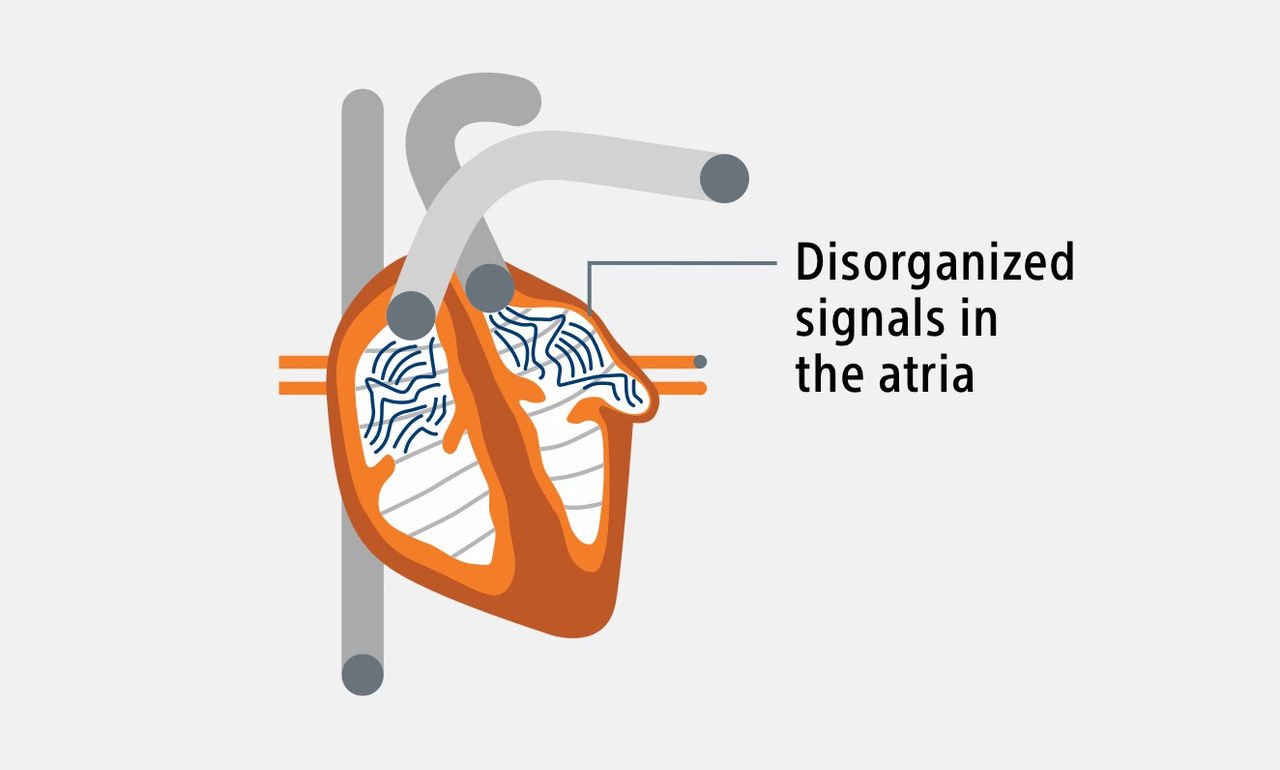Atrial fibrillation (AFib) is a condition that causes an irregular heartbeat. While an irregular heartbeat may not sound very serious, it may be more dangerous than many people realize. AFib can double the risk of death for people living with it.1 And AFib means a five times higher risk of stroke.1 It’s important to understand AFib risks and how to reduce them.
AFib is more than just an irregular heartbeat
AFib happens when the heart tissue or heart’s electrical system is damaged. With AFib, the upper chambers of the heart (called the atria) quiver erratically, causing an irregular or uneven contraction. AFib is a progressive disease, meaning it gets worse over time.1,2

AFib and stroke risk
When the heart doesn’t contract efficiently, blood can pool in the atria and form clots. Most blood clots form in a part of the atria called the left atrial appendage (LAA). These clots can travel from the heart to the brain. If the blood clot blocks an artery in the brain, it can cut off blood flow, causing brain cells to die.3 Stroke is a leading cause of death and disability in the United States.4
AFib and heart failure risk
Heart failure is when the heart can’t pump enough blood to meet the body’s needs. AFib can make it harder for the heart to properly fill with blood because the heartbeat is too fast or uneven.5 Having AFib increases the risk of heart failure by about 18%.6 Over time, heart failure can lead to other serious health problems, including kidney failure, liver problems, and sudden cardiac death.7
Find out if you’re a candidate for the WATCHMAN Implant. Take the quiz
Managing AFib risks
Treatments to manage the heart’s rhythm and rate can help treat the symptoms of AFib. Examples of AFib treatments include:
- Medications to manage heart rate and rhythm in AFib8
- Cardiac ablation, which treats the source of AFib by targeting the areas in the heart causing an irregular heartbeat
- Cardioversion, a treatment where a doctor uses sensors attached to your body and a machine to deliver quick, low-energy shocks to correct the irregular heartbeat9
- A pacemaker for AFib is an implant that uses small electrical pulses to help control a dangerously slow heartbeat10
- An implantable cardioverter defibrillator (ICD) is designed to prevent sudden cardiac death. It sends an electric shock to the heart if it detects a dangerously fast heartbeat
Although these treatments can help address the symptoms of AFib, they don’t directly reduce the risk of stroke with AFib.
The risk of stroke is the most important health concern in people with AFib.11 There are two main ways to manage stroke risk in people with AFib — blood thinner medications or medical treatments.
Blood thinners
Blood thinners are medications to help prevent blood clots from forming. By preventing blood clots, blood thinner medications can help lower the risk of having a stroke with AFib.8 Examples of blood thinners for AFib include:
- Coumadin® (warfarin)
- Eliquis® (apixaban)
- Pradaxa® (dabigatran)
- Lixiana® (edoxaban)
- Xarelto® (rivaroxaban)
To continue to protect from the risk of stroke, blood thinners must be taken every day.12 Additionally, blood thinners increase your risk of bleeding.
Learn more how blood thinner medications work.
Minimally-invasive treatments
Medical treatments to manage stroke risk with AFib involve closing off the LAA. Since 90% of harmful blood clots are formed in the LAA, closing it off can prevent those blood clots from causing a stroke.12 This minimally-invasive procedure may be an option for people with AFib not caused by a heart valve problem (called non-valvular AFib).
The WATCHMAN Implant is designed to fit into the LAA and permanently close it off to keep blood clots from escaping. Most people who choose the WATCHMAN Implant are able to stop taking blood thinner medications 45 days after the procedure.*13


There are risks associated with all medical procedures. Please talk with your doctor about the risks and benefits of the WATCHMAN Implant.
Already took the quiz? Return to your personalized experience.
*In a clinical trial, 96% of patients were able to discontinue their blood thinner 45 days after getting the WATCHMAN Implant.
References:
- What Is Atrial Fibrillation? American Heart Association website. Updated March 26, 2025. Accessed May 23, 2025. https://www.heart.org/en/health-topics/atrial-fibrillation/what-is-atrial-fibrillation-afib-or-af
- Atrial Fibrillation Causes and Risk Factors. National Heart, Lung, and Blood Institute website. Updated November 30, 2022. Accessed May 23, 2025. https://www.nhlbi.nih.gov/health/atrial-fibrillation/causes
- Left Atrial Appendage. Cleveland Clinic website. Updated November 13, 2024. Accessed May 23, 2025. https://my.clevelandclinic.org/health/body/left-atrial-appendage
- About Stroke. American Heart Association website. Accessed May 23, 2025. https://www.stroke.org/en/about-stroke
- Why Atrial Fibrillation Matters. American Heart Association website. Updated March 26, 2025. Accessed May 23, 2025. https://www.heart.org/en/health-topics/atrial-fibrillation/why-atrial-fibrillation-af-or-afib-matters
- Zhang, Z., Li, L., Hu, Z. et al. Causal effects between atrial fibrillation and heart failure: evidence from a bidirectional Mendelian randomization study. BMC Med Genomics 16, 187 (2023). https://doi.org/10.1186/s12920-023-01606-8
- Heart Failure: Symptoms & Causes. Mayo Clinic website. Updated January 21, 2025. Accessed May 23, 2025. https://www.mayoclinic.org/diseases-conditions/heart-failure/symptoms-causes/syc-20373142
- Atrial Fibrillation Medications. American Heart Association website. Updated May 14, 2025. Accessed May 23, 2025. https://www.heart.org/en/health-topics/atrial-fibrillation/treatment-and-prevention-of-atrial-fibrillation/atrial-fibrillation-medications
- Cardioversion. Mayo Clinic. Available at: https://www.mayoclinic.org/tests-procedures/cardioversion/about/pac-20385123. Accessed December 5, 2024.
- Surgical Procedures for Atrial Fibrillation. American Heart Association website. Updated May 6, 2025. Accessed May 23, 2025. https://www.heart.org/en/health-topics/atrial-fibrillation/treatment-and-prevention-of-atrial-fibrillation/surgical-procedures-for-atrial-fibrillation-afib-or-af
- How Are Atrial Fibrillation Treatment Options Determined? American Heart Association website. Updated May 6, 2025. Accessed May 23, 2025. https://www.heart.org/en/health-topics/atrial-fibrillation/treatment-and-prevention-of-atrial-fibrillation/treatment-options-of-atrial-fibrillation-afib-or-af
- Blood Thinners. MedlinePlus website. Updated June 27, 2024. Accessed May 23, 2025. https://medlineplus.gov/bloodthinners.html
- Kar S, Doshi SK, Sadhu A, et al. Primary Outcome Evaluation of a Next-Generation Left Atrial Appendage Closure Device: Results From the PINNACLE FLX Trial. Circulation. 2021;143(18):1754-1762. doi:10.1161/CIRCULATIONAHA.120.050117
All images are the property of Boston Scientific. All trademarks are the property of their respective owners.
Content on this web page is for Informational Purposes only and does not constitute medical advice and should not be used for medical diagnoses. Boston Scientific strongly recommends that you consult with your physician on all matters pertaining to your health or to address any clinical/medical questions.
Important Safety Information
The WATCHMAN FLX and WATCHMAN FLX Pro Devices are permanent implants designed to close the left atrial appendage in the heart in an effort to reduce the risk of stroke.
With all medical procedures there are risks associated with the implant procedure and the use of the device. The risks include, but are not limited to, accidental puncture of the heart causing fluid to collect around the heart possibly leading towards the need for an additional procedure, allergic reaction, anesthesia risks, altered mental status or confusion after procedure, arrhythmias (irregular heartbeats), bleeding or throat pain from the TEE (Trans Esophageal Echo) probe, chest pain/discomfort, congestive heart failure, renal failure, excessive bleeding, gastrointestinal bleeding, groin puncture bleed, bruising at the catheter insertion site, groin pain, anemia (reduced red blood cells requiring transfusion), hypotension, infection/pneumonia (example: in or around your heart or lungs), misplacement of the device, improper seal of the appendage or movement of device from appendage wall, clot formation on the device, blood clot or air bubbles in the lungs or other organs, stroke, transient ischemic attack (temporary stroke-like symptoms), cranial bleed (bleeding in or around your brain), thrombosis (blockage of a blood vessel or vein by a clot) and in rare cases death can occur.
Be sure to talk with your doctor so that you thoroughly understand all of the risks and benefits associated with the implantation of the device. SH-2109508-AA

